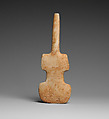On loan to The Met The Met accepts temporary loans of art both for short-term exhibitions and for long-term display in its galleries.
Marble female figure
Technical Analysis: Ultraviolet-induced visible luminescence examination, optical microscopy
This violin-shaped figure, depicting a seated female figure, comprises three parts: an elongated, cylindrical stem representing the head and neck, an uneven trapezoidal surface representing the chest and arms, and a broad, semi-circular lower torso. A v-shaped incision delineates the base of the neck from the flat upper torso. The area of the belly is narrow with a curvilinear silhouette. Three parallel, horizontally incised lines on the belly may indicate a band wrapped around it or possibly a post-partum state. A fourth, curvilinear, incision marks the top of the pelvic triangle that is further delineated by two vertical lines. A dot and faint vertical incision between them indicates the vulva. The back of the figure is plain and smoothened. Faint traces of tool marks are visible on the surface.
This figure is one of the tallest violin-shaped type, which have been found in systematic excavations since 1898.(1) A similar violin-shaped figurine (H. 15.5cm), was excavated by Tsountas on Antiparos.(2) In the Stern Collection of Cycladic Art, L.2022.38.39 is of a similar type. Such schematic violin-shaped figures occur from the early Grotta-Pelos phase to the Kampos Group phases of the Early Cycladic period.
The smoothened surface is covered with brown and reddish-brown burial accretions. There is evidence of old losses under the accretions at the right front neck, the outer left arm, near the back left elbow, and at the bottom back edge. A break across the base of the neck was repaired with an adhesive. Recent wear is visible along the outer edges of the figure, including the top of the head, the left side, the waist, and the underside of the lower edge. The surface is worn and slightly shiny from handling. There are traces of modern adhesive.
Georgios Gavalas and Linda Borsch
(1) For its closest parallel in size and incised anatomical details see Thimme Jürgen. 1977. Art and culture of the Cyclades. no. 40, p. 430 (from “Ios” Norwich, University of East Anglia, R.and L Sainsbury Collection, ex George Ortiz Collection) and no. 41, Karlsruhe: C.F. Müller.
(2) Krassades T117, National Archaeological Museum, Athens inv. no. 4856. See Rambach, Jörg. 2000. Kykladen I, Die Frühe Bronzenzeit Grab- und Siedlungsbefunde. (Athens) pl. 17.6, p. 45, pl. 163.4, Bonn: R. Habelt.
Due to rights restrictions, this image cannot be enlarged, viewed at full screen, or downloaded.
This artwork is meant to be viewed from right to left. Scroll left to view more.





